Solving the selection-recombination equation: ancestral lines and dual processes
Frederic Alberti
Faculty of Mathematics, Bielefeld University, Postbox 100131, 33501 Bielefeld, GermanyEllen Baake
Faculty of Technology, Bielefeld University, PO Box 100 131, D-33501 Bielefeld (Germany)

Abstract
The deterministic selection-recombination equation describes the evolution of the genetic type composition of a population under selection and recombination in a law of large numbers regime. So far, an explicit solution has seemed out of reach; only in the special case of three sites with selection acting on one of them has an approximate solution been found, but without an obvious path to generalisation. We use both an analytical and a probabilistic, genealogical approach for the case of an arbitrary number of neutral sites linked to one selected site. This leads to a recursive integral representation of the solution. Starting from a variant of the ancestral selection-recombination graph, we develop an efficient genealogical structure, which may, equivalently, be represented as a weighted partitioning process, a family of Yule processes with initiation and resetting, and a family of initiation processes. We prove them to be dual to the solution of the differential equation forward in time and thus obtain a stochastic representation of the deterministic solution, along with the Markov semigroup in closed form.
Cite this article
Frederic Alberti, Ellen Baake, Solving the selection-recombination equation: ancestral lines and dual processes. Doc. Math. 26 (2021), pp. 743–793
DOI 10.4171/DM/829